Less Is More: Understanding Network Bias in Proof-of-Work Blockchains
Abstract
:1. Introduction
2. Related Work
3. System Model
3.1. Network Model
3.2. Reward Model
3.3. Action Model
- A miner v specifies a degree which allows v to make outgoing connections;
- A miner v specifies the set of miners to which to connect.
4. Motivation
5. Evaluation
5.1. Simulation Setup
- *
- A block message has an identifier and a reference to the identifier of the block’s parent. We do not include any transactions in a block message, nor do we model bandwidth limitations in the network. When a miner receives a block message, it first validates the block by verifying that it points to a valid parent block in its blockchain. If the received block is valid and extends the longest chain in the blockchain by one, the miner adds the block to its blockchain. It then resets its exponential timer to mine a new block over the latest received block. We set a duration of 1 ms at each miner for this validation operation. Upon validation, the miner immediately sends out the block message to all of its neighbors except the one it received the block from.
- *
- A miner may also receive a block message, whose parent block is unavailable at the miner’s local blockchain replica. In this case, the miner sends a ‘require’ message back to the sender of the block requesting that they also send the parent block. Meanwhile, the received block is stored within an orphan block list at the miner. We set a duration of 1 ms at each miner for this operation as before. When a miner receives a require message, it sends back the requested block as a ‘response’ message. In case the block message received in response to the require message is also such that its parent block is unavailable, a second require message is sent. This process continues until all blocks from the genesis to the first received block are available.
- *
- If a miner receives a block that is not part of the longest chain, it adds the block to the blockchain and does not relay the block to any of the neighbors.
5.2. Results
5.2.1. Reward Bias on a Random Topology
5.2.2. Topologies to Increase Rewards
5.2.3. Alleviating Reward Bias
- First, if the miner has knowledge about the existence of a dominant cluster in the network, it should attempt to connect to as many miners within the cluster as possible and become a part of it.
- When this is not possible, if the miner has knowledge about other miners that are not included in the dominant cluster it should attempt to connect to as many of those miners as possible to form as large a non-dominant cluster in the network as possible.
5.2.4. Randomly Distributed Hash Power
6. Conclusions
Author Contributions
Funding
Data Availability Statement
Conflicts of Interest
References
- Abou Jaoude, J.; Saade, R.G. Blockchain applications—Usage in different domains. IEEE Access 2019, 7, 45360–45381. [Google Scholar] [CrossRef]
- Nakamoto, S. A Peer-to-Peer Electronic Cash System. 2008. Available online: http://bitcoin.org/bitcoin (accessed on 19 November 2023).
- Gilad, Y.; Hemo, R.; Micali, S.; Vlachos, G.; Zeldovich, N. Algorand: Scaling Byzantine Agreements for Cryptocurrencies. In Proceedings of the 26th Symposium on Operating Systems Principle, Shanghai, China, 28–31 October 2017; pp. 51–68. [Google Scholar]
- Bagaria, V.; Kannan, S.; Tse, D.; Fanti, G.; Viswanath, P. Prism: Deconstructing the blockchain to approach physical limits. In Proceedings of the 2019 ACM SIGSAC Conference on Computer and Communications Security, London, UK, 11–15 November 2019; pp. 585–602. [Google Scholar]
- Ethereum. Available online: https://ethereum.org/en/ (accessed on 19 November 2023).
- Dogecoin. Available online: https://dogecoin.com/ (accessed on 19 November 2023).
- Mukhopadhyay, U.; Skjellum, A.; Hambolu, O.; Oakley, J.; Yu, L.; Brooks, R. A brief survey of cryptocurrency systems. In Proceedings of the 2016 14th Annual Conference On Privacy, Security and Trust (PST), Auckland, New Zealand, 12–14 December 2016; IEEE: Piscataway, NJ, USA, 2016; pp. 745–752. [Google Scholar]
- Kroll, J.A.; Davey, I.C.; Felten, E.W. The economics of Bitcoin mining, or Bitcoin in the presence of adversaries. In Proceedings of the 12th Workshop on the Economics of Information Security, Washington, DC, USA, 11–12 June 2013; Volume 2013, p. 11. [Google Scholar]
- Thum, M. The economic cost of bitcoin mining. In Proceedings of the CESifo Forum; ifo Institut-Leibniz-Institut für Wirtschaftsforschung an der Universitat: München, Germany, 2018; Volume 19, pp. 43–45. [Google Scholar]
- Rosenfeld, M. Analysis of hashrate-based double spending. arXiv 2014, arXiv:1402.2009. [Google Scholar]
- Wan, L.; Eyers, D.; Zhang, H. Evaluating the impact of network latency on the safety of blockchain transactions. In Proceedings of the 2019 IEEE International Conference on Blockchain (Blockchain), Atlanta, GA, USA, 14–17 July 2019; IEEE: Piscataway, NJ, USA, 2019; pp. 194–201. [Google Scholar]
- Decker, C.; Wattenhofer, R. Information propagation in the bitcoin network. In Proceedings of the IEEE P2P 2013 Proceedings, Trento, Italy, 9–11 September 2013; pp. 1–10. [Google Scholar]
- Gencer, A.E.; Basu, S.; Eyal, I.; Van Renesse, R.; Sirer, E.G. Decentralization in bitcoin and ethereum networks. In Proceedings of the International Conference on Financial Cryptography and Data Security; Springer: Berlin/Heidelberg, Germany, 2018; pp. 439–457. [Google Scholar]
- Mao, Y.; Deb, S.; Venkatakrishnan, S.B.; Kannan, S.; Srinivasan, K. Perigee: Efficient peer-to-peer network design for blockchains. In Proceedings of the 39th Symposium on Principles of Distributed Computing, Virtual, Italy, 3–7 August 2020; pp. 428–437. [Google Scholar]
- Rohrer, E.; Tschorsch, F. Kadcast: A Structured Approach to Broadcast in Blockchain Networks. In Proceedings of the 1st ACM Conference on Advances in Financial Technologies, Zurich, Switzerland, 21–23 October 2019; pp. 199–213. [Google Scholar]
- Park, S.; Im, S.; Seol, Y.; Paek, J. Nodes in the bitcoin network: Comparative measurement study and survey. IEEE Access 2019, 7, 57009–57022. [Google Scholar] [CrossRef]
- Zhang, Y.; Venkatakrishnan, S.B. Kadabra: Adapting Kademlia for the Decentralized Web. arXiv 2022, arXiv:2210.12858. [Google Scholar]
- Falcon. 2020. Available online: https://www.falcon-net.org/ (accessed on 19 November 2023).
- Klarman, U.; Basu, S.; Kuzmanovic, A.; Sirer, E.G. bloxroute: A scalable trustless blockchain distribution network whitepaper. IEEE Internet Things J. 2018, 8–14. [Google Scholar] [CrossRef]
- FIBRE. 2020. Available online: https://bitcoinfibre.org/ (accessed on 19 November 2023).
- Ozisik, A.P.; Andresen, G.; Bissias, G.; Houmansadr, A.; Levine, B. Graphene: A new protocol for block propagation using set reconciliation. In Data Privacy Management, Cryptocurrencies and Blockchain Technology; Springer: Berlin/Heidelberg, Germany, 2017; pp. 420–428. [Google Scholar]
- Chawla, N.; Behrens, H.W.; Tapp, D.; Boscovic, D.; Candan, K.S. Velocity: Scalability improvements in block propagation through rateless erasure coding. In Proceedings of the 2019 IEEE International Conference on Blockchain and Cryptocurrency (ICBC), Seoul, Republic of Korea, 14–17 May 2019; pp. 447–454. [Google Scholar]
- Croman, K.; Decker, C.; Eyal, I.; Gencer, A.E.; Juels, A.; Kosba, A.; Miller, A.; Saxena, P.; Shi, E.; Sirer, E.G.; et al. On scaling decentralized blockchains. In Proceedings of the International Conference on Financial Cryptography and Data Security; Springer: Berlin/Heidelberg, Germany, 2016; pp. 106–125. [Google Scholar]
- Etherscan: Forked Blocks. Available online: https://etherscan.io/blocks_forked (accessed on 19 November 2023).
- Etherscan: Top 25 Miners by Blocks. Available online: https://etherscan.io/stat/miner?range=14&blocktype=blocks (accessed on 19 November 2023).
- How to Build an Ethereum Mining Pool. Available online: https://medium.com/dragonfly-research/how-to-build-an-ethereum-mining-pool-6be356520b7a (accessed on 19 November 2023).
- The Secret Weapon F2Pool Used to Tackle Its Uncle Rate. Available online: https://medium.com/bloxroute/the-secret-weapon-f2pool-used-to-tackle-its-uncle-rate-1ecb6fe47ef8 (accessed on 19 November 2023).
- A Look at Eth’s Uncle Rate. Available online: https://medium.com/bloxroute/a-look-at-eths-uncle-rate-7eb9013a572e (accessed on 19 November 2023).
- BloXroute. Available online: https://bloxroute.com/ (accessed on 19 November 2023).
- Wang, T.; Zhao, C.; Yang, Q.; Zhang, S.; Liew, S.C. Ethna: Analyzing the Underlying Peer-to-Peer Network of Ethereum Blockchain. IEEE Trans. Netw. Sci. Eng. 2021, 8, 2131–2146. [Google Scholar] [CrossRef]
- Shahsavari, Y.; Zhang, K.; Talhi, C. A theoretical model for fork analysis in the bitcoin network. In Proceedings of the 2019 IEEE International Conference on Blockchain (Blockchain), Atlanta, GA, USA, 14–17 July 2019; pp. 237–244. [Google Scholar]
- Xiao, Y.; Zhang, N.; Lou, W.; Hou, Y.T. Modeling the impact of network connectivity on consensus security of proof-of-work blockchain. In Proceedings of the IEEE INFOCOM 2020—IEEE Conference on Computer Communications, Toronto, ON, Canada, 6–9 July 2020; pp. 1648–1657. [Google Scholar]
- Cao, T.; Decouchant, J.; Yu, J.; Esteves-Verissimo, P. Characterizing the Impact of Network Delay on Bitcoin Mining. In Proceedings of the 40th IEEE International Symposium on Reliable Distributed Systems (SRDS), Chicago, IL, USA, 20–23 September 2021; pp. 109–119. [Google Scholar]
- Putri, B.D.C.; Sari, R.F. The effect of latency on selfish-miner attack on block receive time bitcoin network using NS3. In Proceedings of the 12th IEEE International Conference on Telecommunication Systems, Services, and Applications (TSSA), Yogyakarta, Indonesia, 4–5 October 2018; pp. 1–5. [Google Scholar]
- Eyal, I.; Sirer, E.G. Majority is not enough: Bitcoin mining is vulnerable. In Proceedings of the International Conference on Financial Cryptography and Data Security; Springer: Berlin/Heidelberg, Germany, 2014; pp. 436–454. [Google Scholar]
- OMNeT++ Discrete Event Simulator. Available online: https://omnetpp.org/ (accessed on 19 November 2023).
- Bitnodes Network. 2020. Available online: https://bitnodes.earn.com/ (accessed on 19 November 2023).
- Dong, G.; Tang, M.; Wang, Z.; Gao, J.; Guo, S.; Cai, L.; Gutierrez, R.; Campbel, B.; Barnes, L.; Boukhechba, M. Graph neural networks in IoT: A survey. ACM Trans. Sens. Netw. 2023, 19, 1–50. [Google Scholar] [CrossRef]
- Dong, G.; Cai, L.; Datta, D.; Kumar, S.; Barnes, L.; Boukhechba, M. Influenza-like symptom recognition using mobile sensing and graph neural networks. Proc. Conf. Health Inference Learn. 2021, 291–300. [Google Scholar] [CrossRef]
- Dong, G.; Tang, M.; Cai, L.; Barnes, L.; Boukhechba, M. Semi-supervised graph instance transformer for mental health inference. In Proceedings of the 2021 20th IEEE International Conference on Machine Learning and Applications (ICMLA), Pasadena, CA, USA, 13–16 December 2021; pp. 1221–1229. [Google Scholar]
- Xue, B.; Mao, Y.; Venkatakrishnan, S.B.; Kannan, S. Goldfish: Peer selection using Matrix completion in unstructured P2P network. arXiv 2023, arXiv:2303.09761. [Google Scholar]
- Vedula, A.; Gupta, A.; Venkatakrishnan, S.B. Cobalt: Optimizing Mining Rewards in Proof-of-Work Network Games. In Proceedings of the 2023 IEEE International Conference on Blockchain and Cryptocurrency (ICBC), Dubai, United Arab Emirates, 1–5 May 2023; pp. 1–9. [Google Scholar]
- Wei, J.; Bojja Venkatakrishnan, S. DecVi: Adaptive Video Conferencing on Open Peer-to-Peer Networks. In Proceedings of the 24th International Conference on Distributed Computing and Networking, Kharagpur, India, 4–7 January 2023; pp. 336–341. [Google Scholar]
- BIP-152. 2016. Available online: https://reference.cash/protocol/forks/bip-0152/ (accessed on 19 November 2023).
- Nagayama, R.; Banno, R.; Shudo, K. Identifying impacts of protocol and internet development on the bitcoin network. In Proceedings of the 2020 IEEE Symposium on Computers and Communications (ISCC), Rennes, France, 7–10 July 2020; pp. 1–6. [Google Scholar]
- Bag, S.; Ruj, S.; Sakurai, K. Bitcoin block withholding attack: Analysis and mitigation. IEEE Trans. Inf. Forensics Secur. 2016, 12, 1967–1978. [Google Scholar] [CrossRef]
- Sapirshtein, A.; Sompolinsky, Y.; Zohar, A. Optimal selfish mining strategies in bitcoin. In Proceedings of the International Conference on Financial Cryptography and Data Security; Springer: Berlin/Heidelberg, Germany, 2016; pp. 515–532. [Google Scholar]
- Zhang, M.; Zhang, X.; Zhang, Y.; Lin, Z. {TXSPECTOR}: Uncovering attacks in ethereum from transactions. In Proceedings of the 29th USENIX Security Symposium (USENIX Security 20), Virtual Event, 12–14 August 2020; USENIX Association: Berkeley, CA, USA, 2020; pp. 2775–2792. [Google Scholar]
- Neudecker, T.; Hartenstein, H. Short paper: An empirical analysis of blockchain forks in bitcoin. In Proceedings of the International Conference on Financial Cryptography and Data Security; Springer: Berlin/Heidelberg, Germany, 2019; pp. 84–92. [Google Scholar]
- Lewenberg, Y.; Bachrach, Y.; Sompolinsky, Y.; Zohar, A.; Rosenschein, J.S. Bitcoin mining pools: A cooperative game theoretic analysis. In Proceedings of the 2015 International Conference on Autonomous Agents and Multiagent Systems, Istanbul Turkey, 4–8 May 2015; pp. 919–927. [Google Scholar]
- Dogechain Whitepaper. Available online: https://dogechain.dog/DogechainWP.pdf (accessed on 19 November 2023).
- Lite Coin Whitepaper. Available online: https://whitepaper.io/document/683/litecoin-whitepaper (accessed on 19 November 2023).
- Zero to Monero: First Edition. Available online: https://www.getmonero.org/library/Zero-to-Monero-1-0-0.pdf (accessed on 19 November 2023).
- Varga, A.; Hornig, R. An overview of the OMNeT++ simulation environment. In Proceedings of the 1st iNternational Conference on Simulation Tools and Techniques for Communications, Networks and Systems & Workshops, Marseille, France, 3–7 March 2008; pp. 1–10. [Google Scholar]
- Bitnodes Network Snapshot. Available online: https://bitnodes.earn.com/nodes/ (accessed on 19 November 2023).
- Global Ping Statistics. Available online: https://wondernetwork.com/pings (accessed on 19 November 2023).
- Gervais, A.; Ritzdorf, H.; Karame, G.O.; Capkun, S. Tampering with the delivery of blocks and transactions in bitcoin. In Proceedings of the 22nd ACM SIGSAC Conference on Computer and Communications Security, Denver, CO, USA, 12–16 October 2015; pp. 692–705. [Google Scholar]
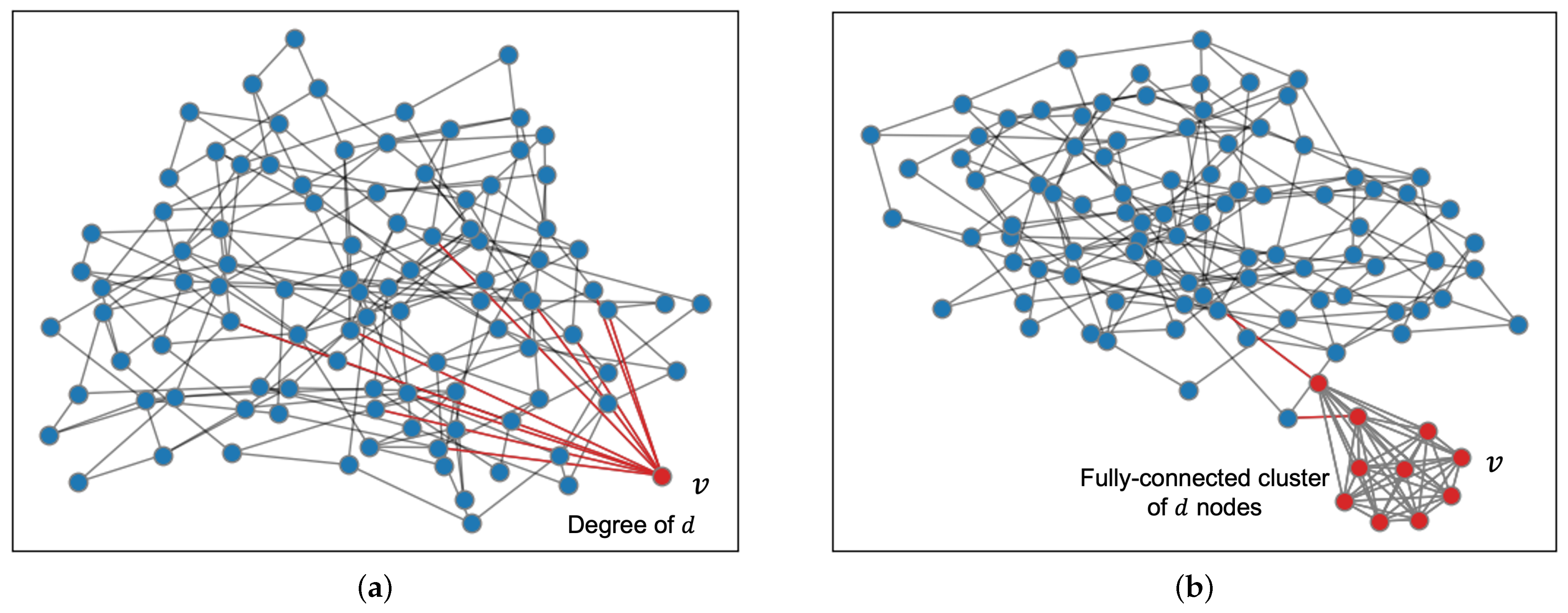
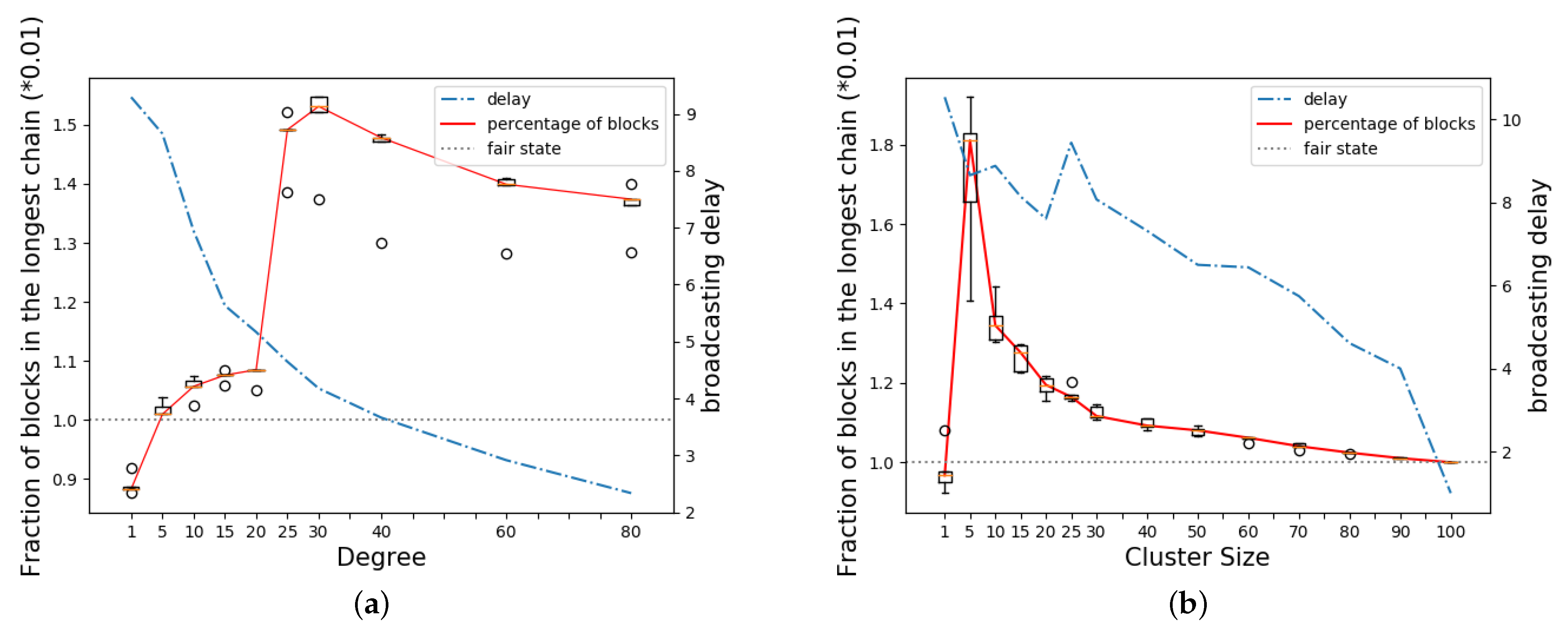
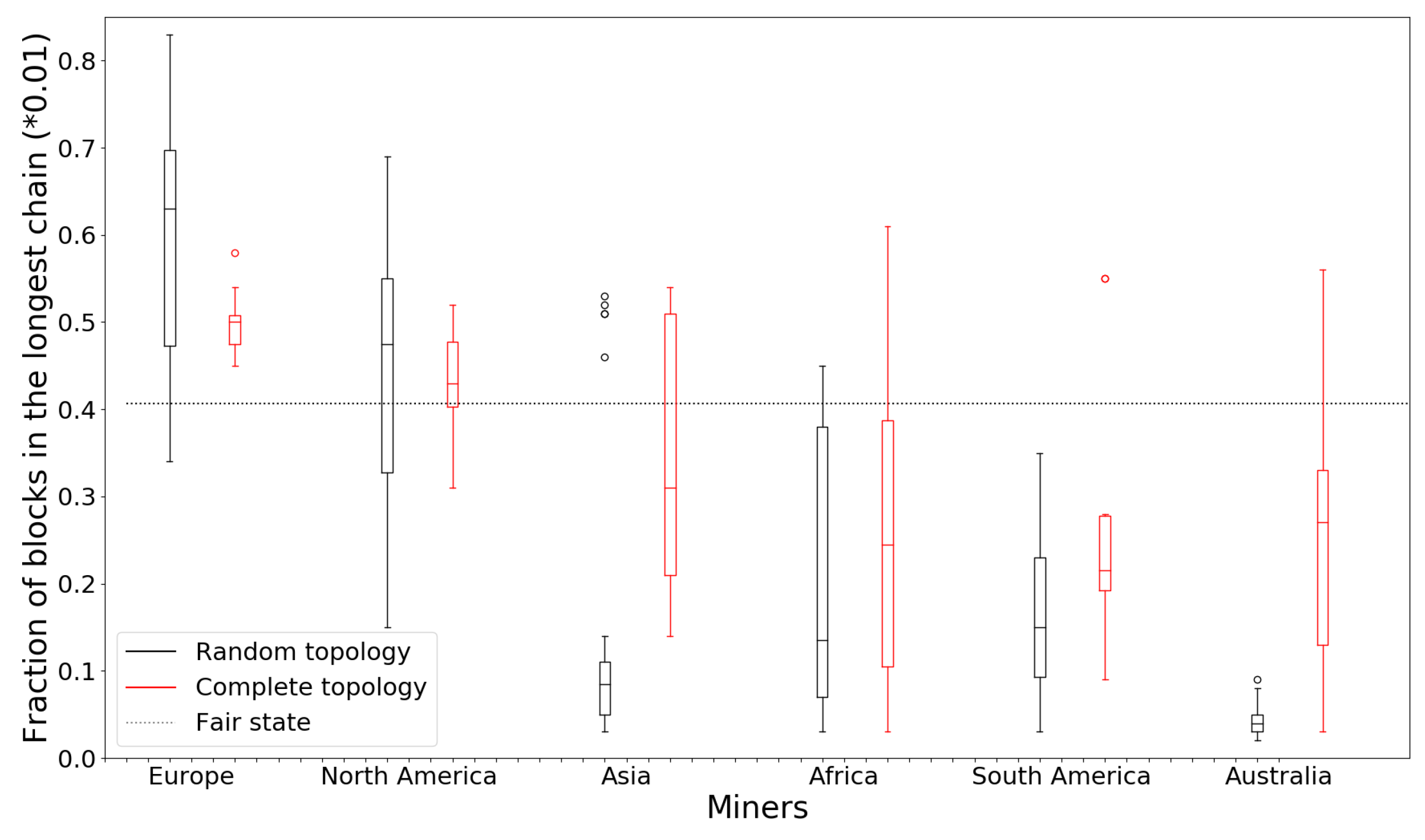


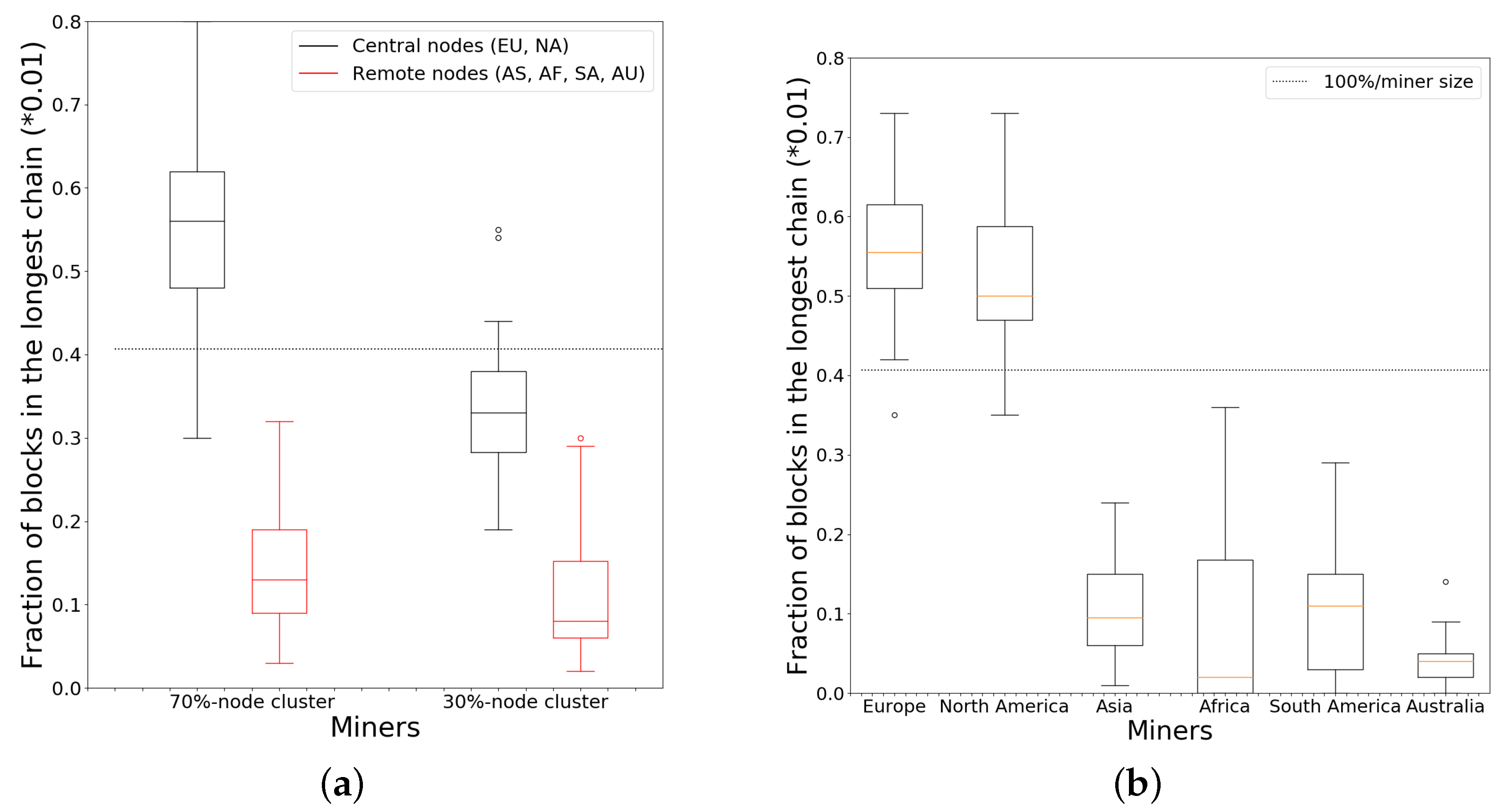

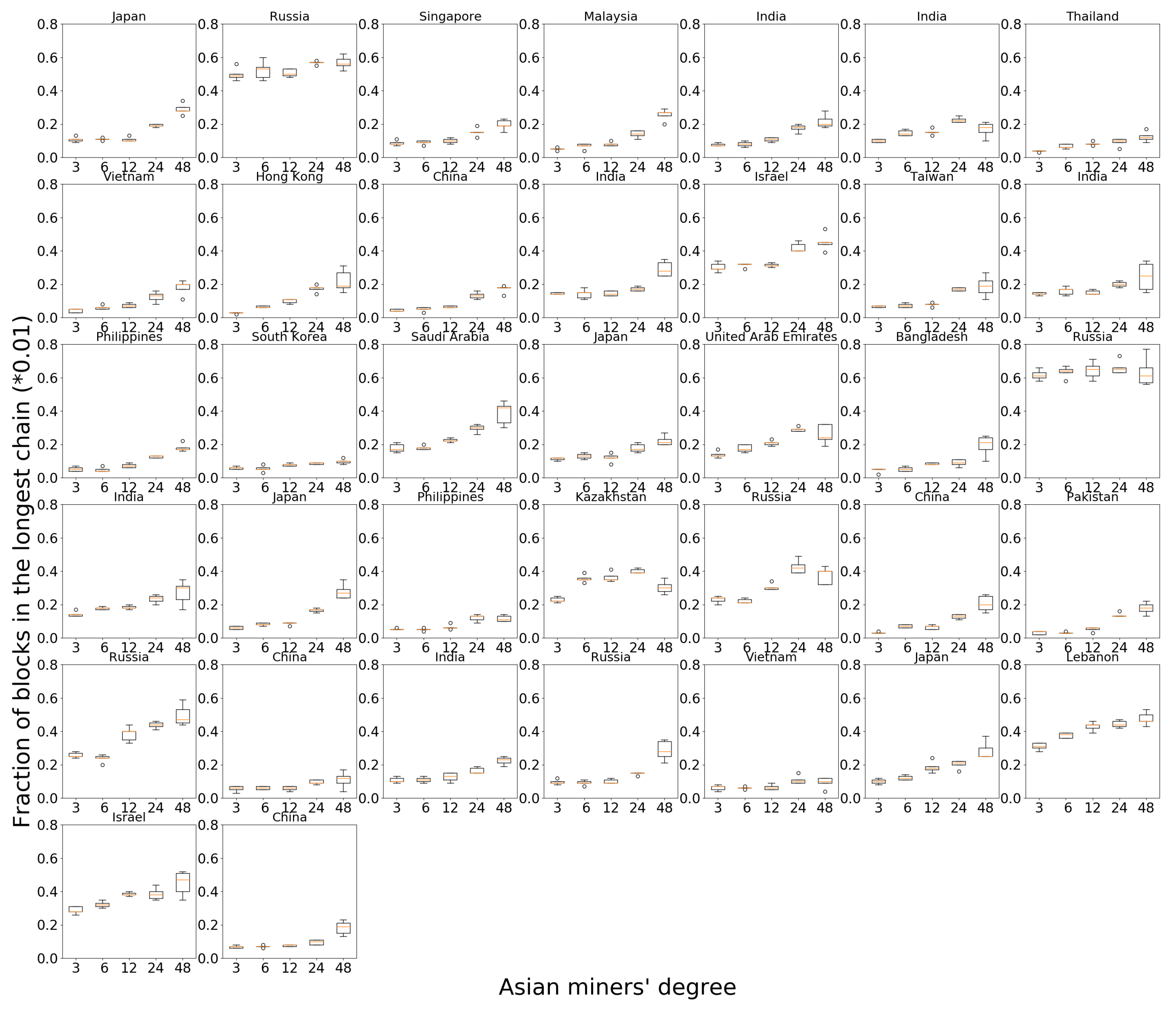
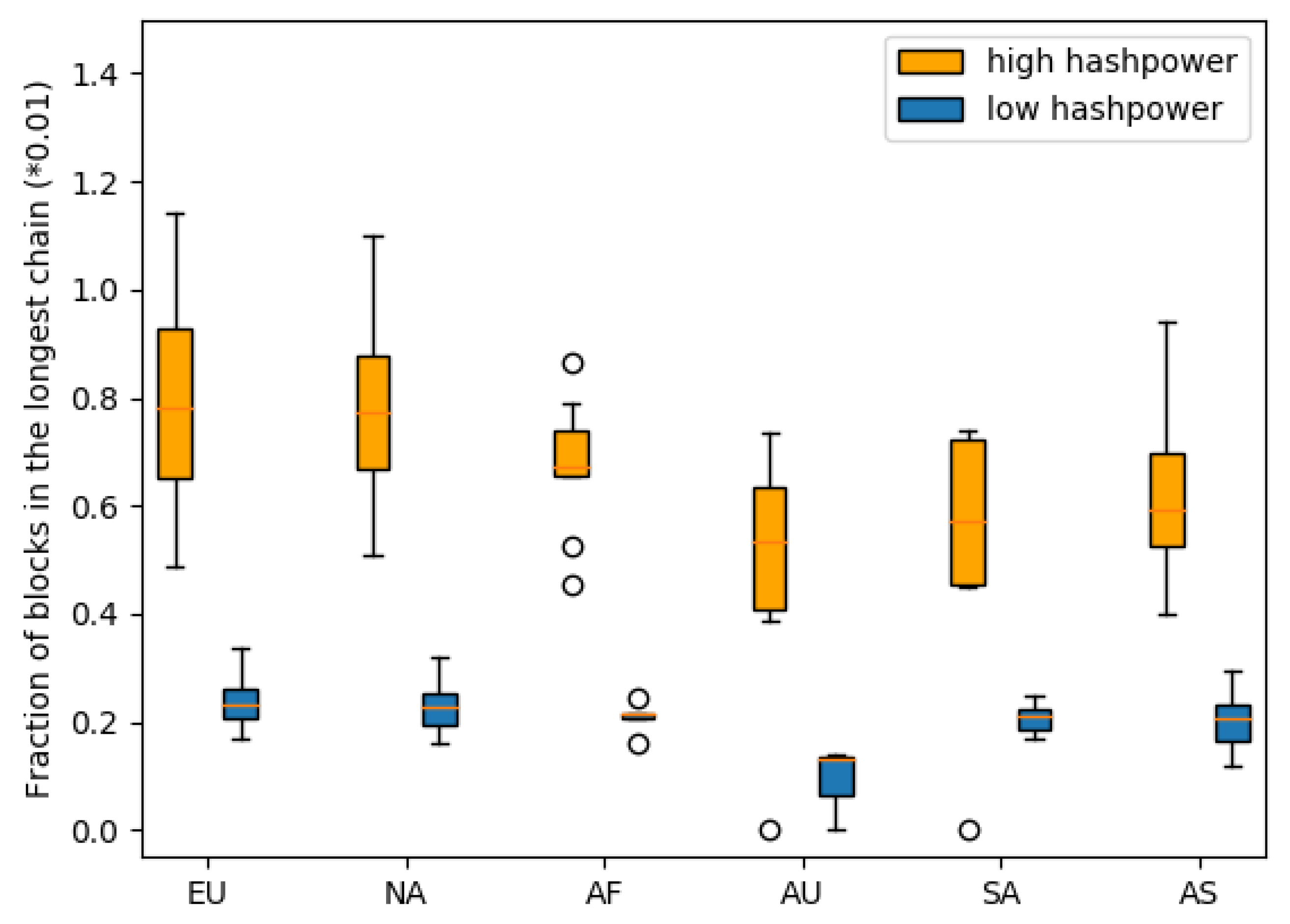
Disclaimer/Publisher’s Note: The statements, opinions and data contained in all publications are solely those of the individual author(s) and contributor(s) and not of MDPI and/or the editor(s). MDPI and/or the editor(s) disclaim responsibility for any injury to people or property resulting from any ideas, methods, instructions or products referred to in the content. |
© 2023 by the authors. Licensee MDPI, Basel, Switzerland. This article is an open access article distributed under the terms and conditions of the Creative Commons Attribution (CC BY) license (https://creativecommons.org/licenses/by/4.0/).
Share and Cite
Mao, Y.; Venkatakrishnan, S.B. Less Is More: Understanding Network Bias in Proof-of-Work Blockchains. Mathematics 2023, 11, 4741. https://doi.org/10.3390/math11234741
Mao Y, Venkatakrishnan SB. Less Is More: Understanding Network Bias in Proof-of-Work Blockchains. Mathematics. 2023; 11(23):4741. https://doi.org/10.3390/math11234741
Chicago/Turabian StyleMao, Yifan, and Shaileshh Bojja Venkatakrishnan. 2023. "Less Is More: Understanding Network Bias in Proof-of-Work Blockchains" Mathematics 11, no. 23: 4741. https://doi.org/10.3390/math11234741
APA StyleMao, Y., & Venkatakrishnan, S. B. (2023). Less Is More: Understanding Network Bias in Proof-of-Work Blockchains. Mathematics, 11(23), 4741. https://doi.org/10.3390/math11234741






